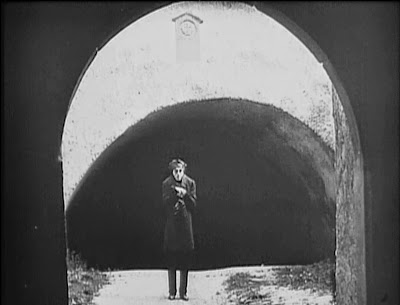I probably don't need to tell you that Nosferatu is a landmark of horror, silent film, and German expressionism, and a film that, though it's quickly approaching its hundredth birthday, still retains an unsettling, eerie power, still has the magic, still has the juice, hasn't turned into a quaint museum piece, still feels alive, but I will anyway. If you haven't seen it, what are you waiting for, you knucklehead? It's even streaming on the various streaming services in the streaming game we're all so crazy about right now. (Support your local video stores.)
Directed by one of the great poets of silent cinema, F.W. Murnau, in that amazing era of German film brought to an end a decade later by the Nazis, Nosferatu feels both timeless and of its time, a snapshot of what Germany was about to become as well as a classic story fitting any occasion. That classic story, though, is what almost robbed us of the film. Denied permission to adapt Bram Stoker's Dracula by Stoker's widow Florence, Nosferatu's producer Albin Grau went ahead and did it anyway, changing a few details, renaming the film, and making the Count's name Orlok. The Stoker estate sued and won, and the judge ordered all copies of the film destroyed. Fortunately, one print made its way to the United States, ensuring the survival of this amazing film. The filmmakers were copyright scofflaws, that can't be denied, but come on, Florence. Lighten up. A book is a book and a movie is a movie, and I'm glad we have both.
Speaking of the movie, I'm going to skip the plot synopsis this time around, because I'm sure most of you have read Dracula, seen some movie or television version of it, heard the story from someone, seen a parody of it, or experienced a combo platter of the preceding scenarios. The biggest difference is the film's biggest flaw; the women characters are either eliminated entirely or reduced in importance. I'm not sure why this choice was made, but it's the only poor choice in what is otherwise a magic blend of talent, skill, and artistic instinct. This film is still scary, it's still creepy, and it's full of powerful images aided by what Werner Herzog (who remade this film in 1979) calls "the voodoo of location."
The oldest surviving vampire film, Nosferatu remains one of the most perverse. This Count is not a handsome, erotically charismatic seducer. He's a rat-toothed, pasty, bald, rail-thin creature with pointed ears and long fingernails, his large, round, unblinking eyeballs always intensely and intently boring into the objects of his vision. He doesn't hide his thirst for blood, and his movements are not graceful. He either simply appears or skulks, hunched, rodent-like. He sometimes seems impossibly tall. At other moments, he appears shriveled. This is an immediately unsettling character, and actor Max Schreck seems to be channeling pure darkness instead of performing a role. He is Nosferatu. I'm disturbed, and I love it.
Murnau, that early master of light and shadow, is on fire in this movie. It's hard to stop oohing and aahing over his images. Though, like most silent film directors, sizable chunks of his filmography have been lost, his surviving work presents a varied yet aesthetically consistent portrait of an innately gifted master. Besides Nosferatu, Murnau's films include The Last Laugh, Faust, Tartuffe, Sunrise, and Tabu. Tabu, a collaboration with Nanook of the North documentarian Robert Flaherty (though Flaherty thought Murnau was an arrogant jerk who reneged on his idea to have Flaherty codirect the film), combined documentary and melodrama, silent film and sound, and was unfortunately his last film. It would have been fascinating to see what Murnau would have done in Hollywood with sound film, but he died at the age of 42 in a 1931 car accident in Santa Barbara. It was an open secret that Murnau was gay, and he had a particular fascination with handsome teenage boys. He hired his drivers based on their looks, not their skills, and on that day in 1931, he employed a 14-year-old boy who had recently emigrated from the Philippines. The boy, inexperienced behind the wheel and relatively unfamiliar with the city streets, crashed into a pole, killing himself and Murnau. (Though Kenneth Anger in Hollywood Babylon presents the Hollywood rumor mill version of events that Murnau was performing oral sex on the boy while the boy was driving, so that could be the true cause of the accident. PSA time: don't drive while sexing it up. That seems even more dangerous than texting. Also, if you're in your forties, don't have sex with teenagers. That should go without saying.)
Murnau may have been an arrogant jerk, a reckless driver/passenger, a pedophile, a copyright infringer, and a man who made poor decisions (other than getting the hell out of Germany before the Nazis took control, that was a pretty solid decision), but he was a hell of a filmmaker, and Nosferatu is one of his best.
Saturday, March 21, 2015
Subscribe to:
Post Comments (Atom)









No comments:
Post a Comment